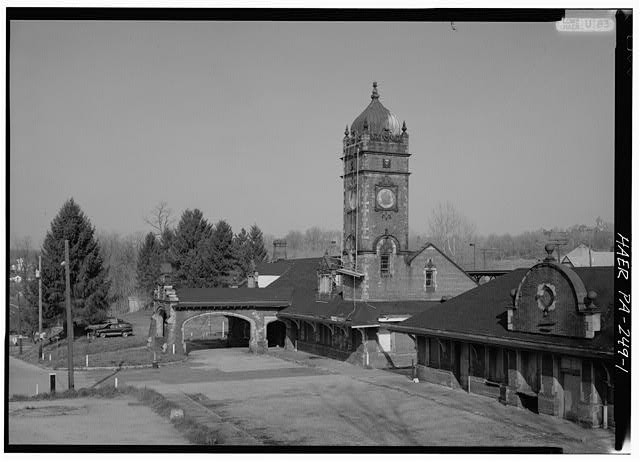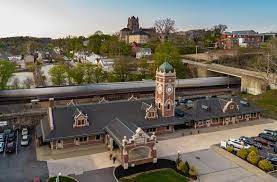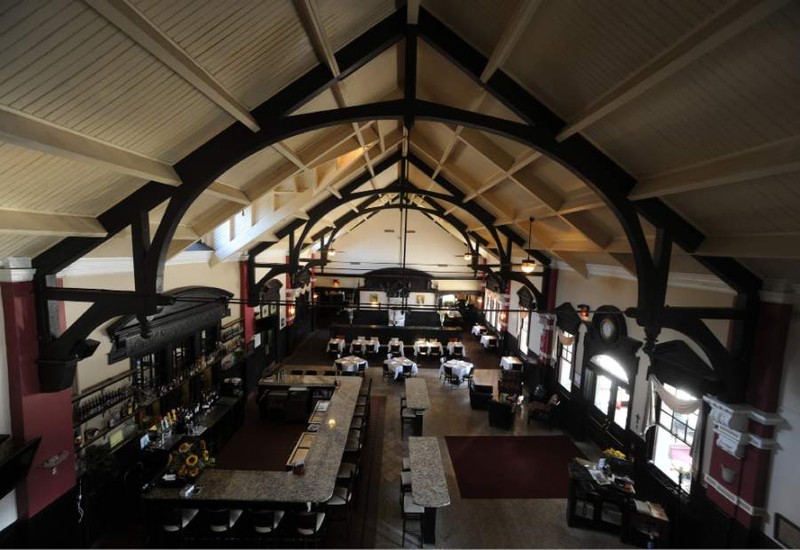Greensburg Train Station
Introduction
Text-to-speech Audio
The Greensburg train station was built in 1910 in Greensburg, PA which is the seat of Westmoreland County. The train station was designed by William H Cookman who was an architect and engineer of the Pennsylvania railroads. Cookman designed the station in the Jacobean architectural style which involved lots of symmetry with stone or brick, vaulting techniques, truss designs, and heavy vertical timbers. The Greensburg train station is still an active train station but has also been adapted into offices as well as a restaurant named Olives & Peppers. The Greensburg train station was listed on the National Register of Historic Places in 1977.
Images
Photo of Greensburg Train Station

"A Norfolk Southern freight train passes the Greensburg Depot in this neutral density long exposure from a drone"

Birdseye view of the inside the part of the train station that was remodeled into a restaurant.

Backstory and Context
Text-to-speech Audio
The Greensburg train station is located at Harrison Avenue and Seton Hill Drive, Greensburg PA. Greensburg is a part of Westmoreland County which was created in 1773 and was named after Nathanael Greene who was an American Revolutionary war general. The Greensburg train station is a part of the Pennsylvania railroad which was established in 1864 that ran from Philadelphia to Pittsburgh.
By the nineteenth century, the development of railroad networks like the Greensburg train station allowed Pennsylvania to share and easily transport goods. Pennsylvania had resources like timber, coal, and iron that became more accessible to companies far away. This led to an increase in immigrant workers willing to work low-paying jobs in the railroad industry. By 1840 and 1850, Pennsylvania was a national leader in railroad development. However, the success of the train stations soon came to an end when automobiles became popular and universal. Instead of trains and railroads, people were buying their own cars and new highways were being built. The Pennsylvania railroads went bankrupt, which led to the closing of the Greensburg train station.
The Greensburg train station was built in 1910 and was designed by William H Cookman who was a staff architect and engineer of the Pennsylvania railroad from 1894 to the 1930s. Cookman went to the University of Pennsylvania and became a member of the Philadelphia Chapter of the American Institute of Architects in 1912. Cookman decided on a Jacobean architectural style when designing the station. Jacobean architecture was a style that came about in England at the end of the sixteenth century during the reign of King James I of England (James VI of Scotland) who came after Queen Elizabeth I. This style was used during the second phase of the Renaissance and combined styles from the Elizabethan era and newer ideas from Europe’s Renaissance.
The Jacobean style was an intensified version of the Elizabethan style which had vaulting techniques, truss designs, and heavy vertical timbers. The Jacobean style was mainly about symmetry. It used Palladian techniques like columns and pilasters with capitals or arcades and stone or brick was traditionally used. Also incorporated were flat roofs or the Flemish gable roof. Staircases were the main focal point and mullioned windows were very common. Regarding the Greensburg train station, brick flooring was used and laid in a Flemish bond pattern with stone trim and the “passenger depot had symmetrically paired Jacobean-style dormers with windows and elaborate gables with scrollwork pediments; its roof ends are gabled” (Greensburg, PA GNB). There are carved and decorative stone squares set on the walls and on top of windows.
The station saw much vandalism over the years until it was taken over by The Westmoreland Cultural Trust which is a non-profit organization that wanted to restore the historic parts of the Greensburg area. The Trust completed a three-million-dollar restoration of the train station in 1998. Though the station had its ups and downs it is still a symbol of the history of Greensburg and is still in use in both traditional and nontraditional train station ways. The station now has offices and a restaurant called Olives & Peppers in it and the station was used in the recent Amazon series A League of Their Own, which had many travelers come to get a glimpse of the set, giving Greensburg some attention. The Greensburg train station was listed in the National Register of Historic Places in 1977.
Sources
- Greensburg history. (n.d.). Retrieved September 26, 2022, from https://thinkgreensburg.com/greensburg-history/
- Greensburg, PA (GNB). Great American Stations. (n.d.). Retrieved September 26, 2022, from https://www.greatamericanstations.com/stations/greensburg-pa-gnb/
- Greensburg Railroad Station - Archinform.net. (n.d.). Retrieved September 27, 2022, from https://www.archinform.net/projekte/36173.htm
- “History of Railroads in Pennsylvania.” PA Digital, 7 June 2021, https://padigital.org/primary-source-sets/history-of-railroads/.
- Marker. Historical Marker. (2021, February 11). Retrieved September 26, 2022, from https://www.hmdb.org/m.asp?m=166714
- Train station marks its debut a century ago. Welcome. (n.d.). Retrieved September 26, 2022, from https://archive.triblive.com/news/train-station-marks-its-debut-a-century-ago/
- William H. Cookman - Archinform.net. https://www.archinform.net/arch/144578.htm.
“Greensburg Railroad Station, Harrison Avenue, Greensburg, Westmoreland County, PA.” The Library of Congress, https://www.loc.gov/item/pa2740/.
“The Greensburg Train Station.” Brandon Fiume Photography, 28 Apr. 2022, http://www.brandonfiume.com/photos/details/261.
“Old Pittsburgh-Area Train Stations Thrive as Restaurants .” Welcome, https://archive.triblive.com/news/old-pittsburgh-area-train-stations-thrive-as-restaurants/.
